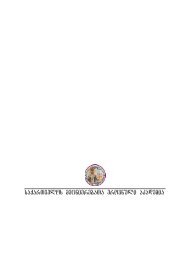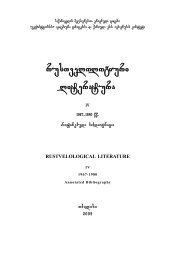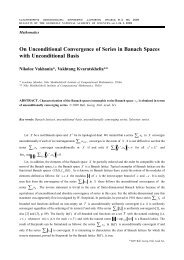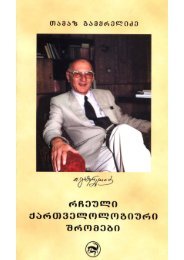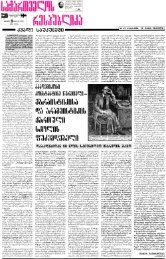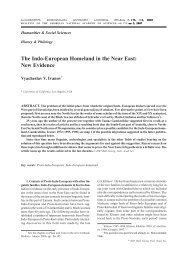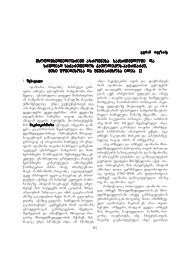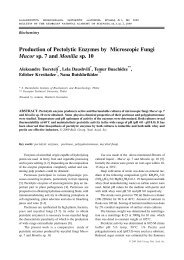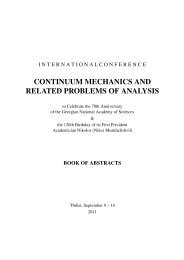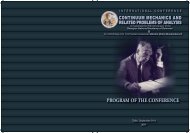Recent Trends in Nostratic Comparative Linguistics - The Georgian ...
Recent Trends in Nostratic Comparative Linguistics - The Georgian ...
Recent Trends in Nostratic Comparative Linguistics - The Georgian ...
Create successful ePaper yourself
Turn your PDF publications into a flip-book with our unique Google optimized e-Paper software.
156 Allan R. Bomhard<br />
8.1. Non-f<strong>in</strong>ite Verb Forms (Derivational Suffixes)<br />
<strong>The</strong> follow<strong>in</strong>g non-f<strong>in</strong>ite verb forms are widespread enough <strong>in</strong> the <strong>Nostratic</strong> daughter languages to guarantee their<br />
common orig<strong>in</strong>, and, consequently, they are listed separately here. However, at the Proto-<strong>Nostratic</strong> level, they were<br />
<strong>in</strong>dist<strong>in</strong>guishable from the nom<strong>in</strong>aliz<strong>in</strong>g suffixes listed above.<br />
Participle: *-na<br />
Participle: *-t h a<br />
Gerundive-participle: *-la<br />
8.2. F<strong>in</strong>ite Verb Forms: Mood Markers<br />
Imperative: *-k h a, *-k h i, *-k h i<br />
Conditional: *-ba<br />
Hortatory-precative: *-li<br />
Inchoative: *-na<br />
Note: the bare stem could also serve as imperative.<br />
8.3. F<strong>in</strong>ite Verb Forms: Others<br />
Causative: *-sV<br />
9.0. Prohibitive/Negative Particles and Indecl<strong>in</strong>ables<br />
<strong>The</strong> follow<strong>in</strong>g negative/prohibitive particles and <strong>in</strong>decl<strong>in</strong>ables can be reconstructed for Proto-<strong>Nostratic</strong>:<br />
Negative particles: *na, *ni, *nu<br />
Prohibitive particle: *ma( )<br />
Negative particle: * al- (~ * @l-)<br />
Negative particle: *li (~ *le) (?)<br />
Negative particle: * e<br />
Post-positional <strong>in</strong>tensify<strong>in</strong>g and conjo<strong>in</strong><strong>in</strong>g particle: *k wh a- (~ *k wh @-)<br />
Particle: *k wh ay- ‘when, as, though, also’<br />
Particle: *ħar y - ‘or; with, and; then, therefore’<br />
Particle: * <strong>in</strong>- (~ * en-), *(-)ni ‘<strong>in</strong>, <strong>in</strong>to, towards, besides, moreover’<br />
Sentence particle: *wa (~ *w@) ‘and, also, but; like, as’<br />
Coord<strong>in</strong>at<strong>in</strong>g conjunction: * aw-, * wa- (~ * w@-) ‘or’<br />
Note: <strong>The</strong> CVC- root structure pattern<strong>in</strong>g of some of these forms po<strong>in</strong>ts to their ultimate nom<strong>in</strong>al or verbal orig<strong>in</strong>.<br />
For example, the negative particle * al- (~ * @l-) must ultimately have been a negative verb stem mean<strong>in</strong>g ‘to be not soand-so’,<br />
as <strong>in</strong> its Dravidian derivatives, while * <strong>in</strong>- (~ * en-), *(-)ni was orig<strong>in</strong>ally a nom<strong>in</strong>al stem mean<strong>in</strong>g ‘place,<br />
location’.<br />
10.0. Remarks on <strong>Nostratic</strong> Sound Correspondences<br />
<strong>The</strong> <strong>Nostratic</strong> sound correspondences given <strong>in</strong> the tables <strong>in</strong> the Appendix to this article are based exclusively<br />
upon the work of Bomhard. <strong>The</strong>y differ <strong>in</strong> several significant respects from the sound correspondences proposed by<br />
the Moscow School, as represented <strong>in</strong> the work of Illič-Svityč and Dolgopolsky. Bomhard bases his views on three<br />
fundamental assumptions:<br />
1. <strong>The</strong> traditional reconstruction of the Proto-Indo-European consonant system is flawed and is to be re<strong>in</strong>terpreted<br />
along the l<strong>in</strong>es proposed, on the one hand, by Thomas V. Gamkrelidze and Vjačeslav V. Ivanov and,<br />
on the other hand, by Paul J. Hopper, as follows (the reconstruction of the Proto-Indo-European stop system<br />
posited by Lehmann is given for comparison):<br />
Lehmann<br />
Gamkrelidze – Ivanov<br />
Bull. Georg. Natl. Acad. Sci., vol. 2, no. 4, 2008



